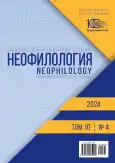Hephyronyms in the structure of the Samarkand text
- Authors: Lipatova Y.V.1
-
Affiliations:
- Samarkand State University named after Sharof Rashidov
- Issue: Vol 10, No 4 (2024)
- Pages: 871-878
- Section: ONOMASTICS
- URL: https://journal-vniispk.ru/2587-6953/article/view/295626
- DOI: https://doi.org/10.20310/2587-6953-2024-10-4-871-878
- ID: 295626
Cite item
Full Text
Abstract
INTRODUCTION. Recently, the peripheral categories of onomastics have become the object of onomastic research, which include the name of the proper bridge – gephyronyms. This term is not noted in the most famous Dictionary of Russian Onomastic Terminology by N.V. Podolskaya. Being a meaningful independent unit of knowledge in the onomastic consciousness of native speakers, gephironim exist in a system-centric form and in an anthropocentric dimension, implementing the urban text. Understanding the essence of the toponym as a text goes back to the ideas of M.V. Gorbanevsky, who believed that the versatility of the components of a toponym is related to the toponym-text. The purpose of the study is to consider the spatial locus of the city of Samarkand based on the material of gephironim texts, which can unfold and represent known extralinguistic and cultural knowledge, representing the city-text.MATERIALS AND METHODS. The following methods are used in the study: observation, semiotic and semantic analysis, interpretation method. Empirical context of the study of – gephyronyms of Samarkand, recorded on the city map and in reference books, which are the object of scientific interest of the author.RESULTS AND DISCUSSION. A person fills the space of the city with specific toponymic units involved in the formation of the urban text, which allows “to read” the city. The coherence and integrity of the urban text are formed by toponyms-texts, the meanings of which include the following components: address, chronological, historical and cultural, local history, national-cultural, text, and this series remains open.CONCLUSION. Certain properties of the Samarkand text are reflected in toponym texts. Since any toponym performs an iconic function and urban semiotics is intertextual, each individual toponym-text enters into an intertextual relationship with another toponym-text, forming an urban text with onomastic information.
About the authors
Ye. V. Lipatova
Samarkand State University named after Sharof Rashidov
Author for correspondence.
Email: lipatova-yevgeniya@mail.ru
ORCID iD: 0000-0003-1224-6019
Lecturer of Russian Language Department
15 University Blvd, Samarkand, 140100, Republic of UzbekistanReferences
- Chirkova N.V. An image of the town in the context of representation of historical and cultural memory: heritage and modernity [review of the book by Anatoly I. Ionesov and Vladimir I. Ionesov. “Samarkand: an image of the town in the space of intercultural communication. an encyclopedia of foreign samarkandiana”. Tashkent, SMI-ASIA, 2022. 852 p.]. Vestnik Chelyabinskogo gosudarstvennogo universiteta =Bulletin of Chelyabinsk State University, 2023, no. 4 (474), pp. 119-123. (In Russ.) https://doi.org/10.47475/1994-2796-2023-474-4-119-123, https://elibrary.ru/lcaflw
- Lipatova E.V. Representation of the Samarkand text in the linguocognitive aspect. Neofilologiya = Neophilol-ogy, 2024, vol. 10, no. 1, pp. 67-75. (In Russ.) https://doi.org/10.20310/2587-6953-2024-10-1-67-75, https://elibrary.ru/vryrio
- Gorbanevskii M.V. Russian Urban Toponymy: Methods of Historical and Cultural Study and Creation of Com-puter Dictionaries. Moscow, Obshchestvo lyubitelei rossiiskoi slovesnosti Publ., 1996, 304 p. (In Russ.)
- Revyakina N.P., Kur’yanov N.A. “City as text” (based on the material from Rostov-on-Don). Rossiiskii lingvis-ticheskii byulleten’ = Russian Linguistic Bulletin, 2023, no. 7 (43), Art. 35. (In Russ.) https://doi.org/10.18454/RULB.2023.43.30, https://elibrary.ru/unwqmr
- Kazakov K.V. City as text: structural and semiotic view. Materialy Mezhdunarodnoi nauchnoi konferentsii «25 Yubileinye tsarskosel’skie chteniya» = Proceedings of International Scientific Conference “25th Anniversary Tsarskoye Selo Readings”. St. Petersburg, Pushkin Leningrad State University Publ., 2021, vol. 2, pp. 31-36. (In Russ.) https://elibrary.ru/yhmmnm
- Toporov V.N. The St. Petersburg text of Russian literature: Selected Works. St. Petersburg, Iskusstvo Publ., 2003, 616 p. (In Russ.) https://elibrary.ru/vnjoij
- Skibinskaya O.N., Khovrina T.K (compilers). Materialy Pyatoi Vserossiiskoi nauchnoi konferentsii s mezhdu-narodnym uchastiem “Yaroslavskii tekst v prostranstve dialoga kul’tur”= Proceedings of the Fifth All-Russian Scientific Conference with International Participation “The Yaroslavl Text in the Space of the Dialogue of Cultures”. Yaroslavl, YSPU Publ., 2023, 422 p. (In Russ.) https://elibrary.ru/pdgxmc
- Yarantsev V.N. Read Peterburg: city as text. Evraziiskii Nauchnyi Zhurnal, 2016, no. 10, pp. 302-309. (In Russ.) https://elibrary.ru/wzzusj
- Berezovich E.L. Toponymic space as a text. Yearbook of the Scientific Research Institute of Russian Culture. Ekaterinburg, Ural Federal University Publ., 1995, pp. 86-95. (In Russ.)
- Golev N.D., Dmitrieva L.M. Unity of the ontological and mental existence of the toponymic system: a contribu-tion to cognitive toponymics. Voprosy onomastiki = Problems of Onomastics, 2008, no. 1 (5), pp. 5-17. (In Russ.) https://elibrary.ru/qhubvd
- Kartavenko V. Semantics of toponym as concentrated text. W kręgu zagadnień semantyki i stylistyki tekstu. Łódź, Wydawnictwo Uniwersytetu Łódzkiego Publ., 2014, pp. 55-64. (In Russ.) https://doi.org/10.18778/7969-416-7.06
- Sharandin A.L. Are proper names lexicо-grammatical category of a noun? Vestnik Moskovskogo gosudarstven-nogo oblastnogo universiteta. Seriya: Russkaya filologiya = Bulletin of Moscow Region State University. Series: Russian Philology, 2021, no. 2, pp. 68-77. (In Russ.) https://doi.org/10.18384/2310-7278-2021-2-68-77, https://elibrary.ru/brckqn
- Shcherbak A.S. The cognitive concept of Russian urbanonyms. Problems of Russian Studies in Terms of Current Prospects. Tambov, Publishing House of Derzhavin Tambov State University, 2017. (In Russ.)
- Shcherbak A.S., Du Ch., Kheh Yu. Urbanonym units study within the cognitive approach. Voprosy kognitivnoi lingvistiki = Issues of Cognitive Linguistics, 2018, no. 4 (57), pp. 88-95. (In Russ.) https://doi.org/10.20916/1812-3228-2018-4-88-95, https://elibrary.ru/yalumx
- Malikov A.M., Talanbaeva K.U. Some features of the cultural identity of Shaybani Khan and the monumental construction in Samarkand at the beginning of the sixteenth century. Zolotoordynskoe obozrenie = Golden Horde Review, 2022, vol. 10, no. 2, pp. 391-413. (In Russ.) https://doi.org/10.22378/2313-6197.2022-10-2.391-413, https://elibrary.ru/gnlnbw
- Madieva G.B., Suprun V.I. General problems of onomastics. Theory and Practice of Onomastic and Derma-tological Research. Maikop, Magarin Oleg Grigorievich Print House, 2017, 444 pp. (In Russ.) https://elibrary.ru/xyjkqx
- Madieva G.B., Suprun V.I. The system of modern Russian urbanonymic terminology. Voprosy onomastiki = Problems of Onomastics, 2017, vol. 14, no. 2, pp. 115-125. (In Russ.) https://doi.org/10.15826/vopr_onom.2017.14.2.014, https://elibrary.ru/yupmad
Supplementary files











